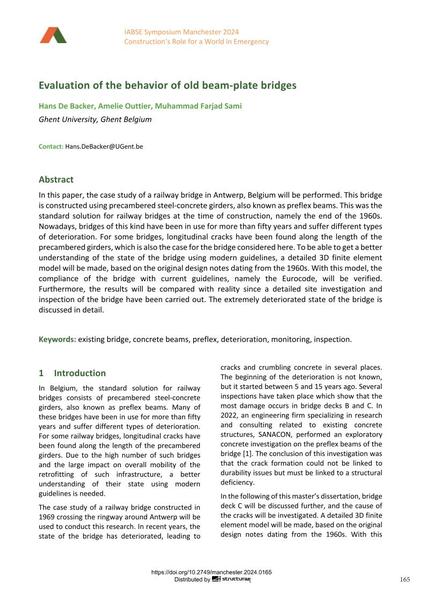Evaluation of the behavior of old beam-plate bridges

|
|
|||||||||||
Détails bibliographiques
| Auteur(s): |
Hans De Backer
(Ghent University, Ghent Belgium)
Amelie Outtier (Ghent University, Ghent Belgium) Muhammad Farjad Sami (Ghent University, Ghent Belgium) |
||||
|---|---|---|---|---|---|
| Médium: | papier de conférence | ||||
| Langue(s): | anglais | ||||
| Conférence: | IABSE Symposium: Construction’s Role for a World in Emergency, Manchester, United Kingdom, 10-14 April 2024 | ||||
| Publié dans: | IABSE Symposium Manchester 2024 | ||||
|
|||||
| Page(s): | 165-172 | ||||
| Nombre total de pages (du PDF): | 8 | ||||
| DOI: | 10.2749/manchester.2024.0165 | ||||
| Abstrait: |
In this paper, the case study of a railway bridge in Antwerp, Belgium will be performed. This bridge is constructed using precambered steel-concrete girders, also known as preflex beams. This was the standard solution for railway bridges at the time of construction, namely the end of the 1960s. Nowadays, bridges of this kind have been in use for more than fifty years and suffer different types of deterioration. For some bridges, longitudinal cracks have been found along the length of the precambered girders, which is also the case for the bridge considered here. To be able to get a better understanding of the state of the bridge using modern guidelines, a detailed 3D finite element model will be made, based on the original design notes dating from the 1960s. With this model, the compliance of the bridge with current guidelines, namely the Eurocode, will be verified. Furthermore, the results will be compared with reality since a detailed site investigation and inspection of the bridge have been carried out. The extremely deteriorated state of the bridge is discussed in detail. |
||||
